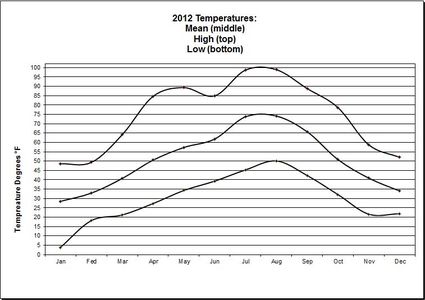January generally normal
Weather Watcher
Last updated 2/20/2013 at 9:17am
Reviewing data from the past four Januarys shows we didn’t have any changes from the normal. We had good, measurable snowfall this year (2013, 7.3 inches) and last (2012, 9.9 inches). Here’s how it broke down for 2013 and showing all-time records in parenthesis. High temperature 46.0°F(record is 61°F), low 12.7°F (record -17°F), mean 26.5°F (record 36.1°F), total precipitation 0.60 inches (2.25 inches) and snowfall 7.3 inches (21.6 inches). January was nothing to write home about. Given the “neutral” rating from the Climate Prediction Center (CPC) for January, I’d say they were correct. The sidebar chart provides the high, low and mean temperatures for 2012.
The CPC is showing lower temperatures from now into April and an “equal” chance of precipitation, meaning, above, normal or below. That’s tough to decipher, I know. So, as they say, we’ll have to wait and see.
As I write this, we’re beginning to see an upward trend in our daily high temperatures. Here at the home weather station, I’m seeing a lot of highs in the lower 40-degree mark. It’s time to start thinking about the tasks needed in the yard. Actually, I really don’t want to think about those tasks just yet!
Speaking of the home weather station, I’ve added a new sensor to mine that measures solar radiation. That measurement is in watts per square meter. The basic graph, obviously, shows how many hours of sunlit daylight and at what intensity.
Hope you’re enjoying the ever increasing daylight we are experiencing. Sunrise and sunsets are changing about a minute every day now as our planet begins to tilt our little geographic area in the northern hemisphere more and more toward the sun.
Stop and take a look at Saturn before the sun rises in the morning. It’s quite visible on the western horizon. Jupiter, Mars and Mercury are also visible in the night sky.
Feb. 25 is a full moon and may interfere with some of the fainter meteors. February lends itself well for meteor showers. There is only one recognized meteor shower, and it’s the minor Alpha Centaurids in the southern sky. Rates for sporadic meteors are about 5 and 10 per hour. Given the very recent fiery atmospheric entry episodes in the Urals of Russia and in the San Francisco Bay Area, we might see something that will make the headlines – keep an eye to the sky.



Reader Comments(0)